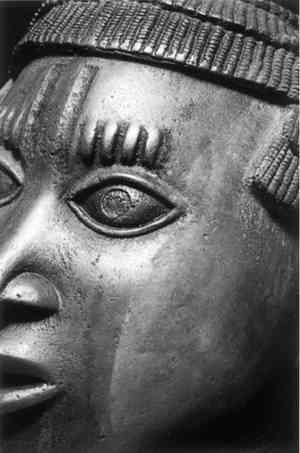WAX COATINGS ON ETHNOGRAPHIC METAL OBJECTS: JUSTIFICATIONS FOR ALLOWING A TRADITION TO WANEDANAL L. MOFFETT
2 COLLECTION AND TREATMENT HISTORYIn 1897, the British military conducted a campaign against the kingdom of Benin (part of present-day Nigeria) in retaliation for the ambush and murder of the newly appointed colonial commissioner. Following the destruction of Benin City and the exile of the king, the military claimed as war prize a large number of cast copper alloy objects, now commonly known as the Benin “bronzes.” (Most Benin castings are technically brass.) Once in Europe, the castings were distributed among collectors, dealers, and museums. The object under consideration, a hollow cast male head dating from the late 15th to
As a new member of the Smithsonian Institution, the NMAfA remained in a group of 19th-century townhouses on Capitol Hill while awaiting completion of its building on the National Mall; the museum was without a professional conservator of its own. Consequently, in 1984, a consulting conservator was asked to advise on the best treatment approach for the head. In trial tests, the conservator found that a solvent cocktail (toluene, ethanol, ethylene dichloride, Cellosolve, and Cellosolve acetate) applied with swabs easily removed the olive-green coating.1 Beneath, the metal surface appeared to be in good physical condition and aesthetically acceptable to the NMAfA curatorial staff (fig. 1). Cleaning of the entire piece proceeded to complete removal, at least visually. The copper formate corrosion products were removed mechanically. Following this treatment, as a precaution against further corrosion, the Benin head was given two coats of Incralac (methyl methacrylate copolymer with benzotriazole) followed by a final layer of Renaissance wax (microcrystalline-polyethylene wax blend) and returned to the old NMAfA building for exhibition. In October 1991, the Benin head was lent to the National Gallery of Art, Washington, D.C., for exhibition in Circa 1492: Art in the Age of Exploration. For several years, the curators had noticed an accumulation of lint and dust on the piece and, in some areas, the 1984 wax coating had become clearly visible as a white haze on the metal surface; casting details seemed muted and flattened (fig. 2). On the
In addition to concerns about the aesthetic problems caused by the coating already noted, it was felt that any protective function the wax might have afforded was no longer required at the new museum building, where exhibition cases are constructed of high-quality materials and where the relative humidity is easily controlled on a general as well as a microenvironmental level. Moreover, Fenn and Foley (1975) reported that industrial research on several types of coatings, including wax, indicates that they do not provide an impervious barrier to water and oxygen, although they may offer protection from contamination during handling. Incomplete or damaged coatings may create electrochemical cells that encourage corrosion to proceed at the points of imperfection. Finally, the Benin head also had been coated with Incralac, which has been shown to age poorly under certain conditions (LaFontaine 1981; Erhardt et al. 1984). These factors, coupled with the aesthetic problems, intensified the desire to remove the lacquer as well as the wax and to leave the surface of this object coating-free, if possible. |

